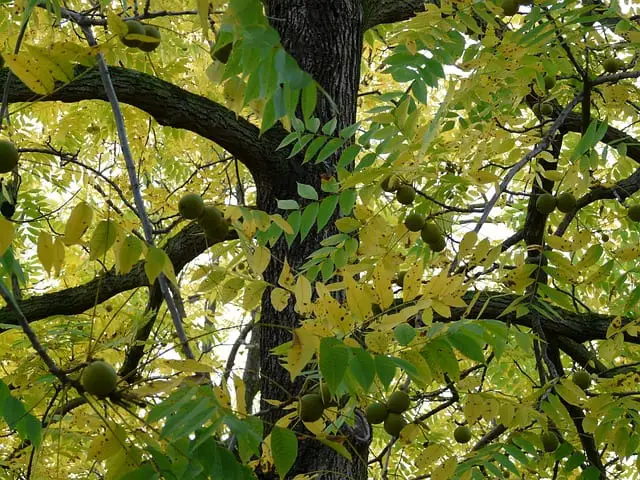While black walnut wood is very versatile as a material for a number of commercial uses, it is not commonly used for smoking food due to its very strong smoke and potential toxicity as well as a lack of availability, among other reasons.
When you buy a bag of walnuts, chances are it is an English walnut variety that you are consuming. While walnut wood can be used for smoking, it will most likely be the English variety whose wood is chosen for its smoking benefits.
Below we’ll discuss why black walnut wood isn’t good for smoking and what it is actually good for.
Why Black Walnut Isn’t A Good Choice For Smoking Foods
Here are the reasons each of these factors makes black walnut an unsuitable choice for smoking foods:
- Flavor Profile: Black walnut wood has a distinct and strong flavor that can be overpowering for some foods. It has a rich, nutty, and slightly bitter taste.
- Toxicity Concerns: Black walnut wood contains a chemical called juglone, which is toxic to certain plants and can inhibit their growth. When using black walnut wood for smoking, there is a slight risk that the juglone may transfer to the food, potentially affecting its taste or causing adverse health effects.
- Availability: Black walnut wood is less commonly available for smoking compared to other woods, such as fruitwoods or hardwoods like oak or hickory. It may be challenging to find black walnut wood depending on where you live.
Black Walnut and English Walnut Wood Compared
When you buy walnuts, they are generally of the English walnut variety as they are commonly grown in parts of Asia and Europe. While both walnuts have their own traits, each type of walnut does have its own unique characteristics too.
Here is a comparison of black walnut and English walnut wood to illustrate what each offers.
| Black Walnut Wood | English Walnut Wood | |
|---|---|---|
| Commercial Use | Furniture, flooring, cabinetry, paneling, musical instruments, decorative items, gunstocks, turning/carving | Furniture, cabinetry, paneling, musical instruments, turning/carving |
| Characteristics | Dark brown color, rich grain patterns, medium to coarse texture, high natural durability | Light to medium brown color, straight grain patterns, fine texture, moderate durability |
| Availability | Native to North America, widely available in the United States | Native to Central Asia and Europe, cultivated in various regions worldwide |
| Profile | Highly valued for its aesthetics, durability, and workability | Highly regarded for its nut production and wood quality |
| Hardness | Moderately hard (Janka hardness: 1,010 lbf) | Moderately hard (Janka hardness: 1,010 lbf) |
| Workability | Relatively easy to work with, but may require special care due to its density | Relatively easy to work with, suitable for turning and carving |
| Common Use | High-quality furniture, flooring, cabinetry, gunstocks | Furniture, cabinetry, turning projects |
It’s important to note that while both black walnut and English walnut wood have their own unique characteristics and commercial uses, they are distinct species with variations in appearance and availability.
Black walnut is highly regarded for its dark color, rich grain patterns, and high natural durability, making it a preferred choice for fine furniture and high-end woodworking projects. English walnut, on the other hand, is known for its lighter color and straight grain patterns, making it suitable for a range of furniture and cabinetry applications.
Availability may vary depending on geographic regions, with black walnut being more widely available in the United States, while English walnut is cultivated in various regions worldwide.
Black Walnut Wood Does Have Many Commercial Uses
Black walnut wood is highly valued for its attractive appearance, durability, and workability, making it suitable for various applications.
Here are some common uses for black walnut wood:
- Furniture: Black walnut is a popular choice for crafting high-quality furniture, including tables, chairs, cabinets, and bed frames. Its rich, dark color and beautiful grain patterns enhance the aesthetics of the pieces.
- Flooring: The hardness and stability of black walnut wood make it an excellent choice for flooring. It provides a warm and inviting look to any space, and its durability ensures longevity.
- Cabinetry: Black walnut is often used for crafting kitchen cabinets, bathroom vanities, and other custom cabinetry. It adds an elegant and timeless touch to the interior design.
- Paneling and Trim: Black walnut wood can be used for wall paneling, wainscoting, and trim work. It adds character and sophistication to any room.
- Musical Instruments: The tonal qualities of black walnut wood make it suitable for crafting musical instruments such as guitars, violins, and ukuleles. It can contribute to a warm and resonant sound.
- Decorative Items: Black walnut wood can be used for creating decorative items like bowls, cutting boards, and sculptures. Its natural beauty and unique grain patterns make these items stand out.
- Gunstocks: Black walnut wood is highly regarded for making gunstocks due to its strength, stability, and attractive appearance.
- Turning and Carving: The workability of black walnut wood makes it a popular choice for woodturning projects like bowls, vases, and spindles. It is also suitable for intricate carving work.
It’s worth noting that black walnut wood can be expensive, primarily due to its desirability and limited availability. However, its quality and aesthetic appeal make it a preferred choice for many woodworking projects.

